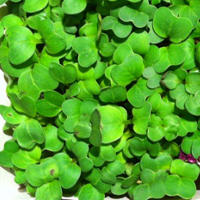How to Grow Daikon Microgreens (Kaiware Sprouts) in Soil

Daikon microgreens, also known as kaiware sprouts, are one of the easiest microgreens to grow at home, indoors or out. Growing these gorgeous microgreens is also a rewarding and fun pastime for the whole family. Daikon microgreens have a pleasantly peppery flavor, reminiscent of mature daikon radishes. They can be used to add flavor to salads, or as a garnish on sashimi and open sandwiches.
Ready to grow your first crop of kaiware sprouts? Follow the steps below and you should be rewarded with a plentiful harvest of fresh microgreens in less than a fortnight!
Step 1. Buy certified-organic daikon seeds from a reputable supplier. Soak the seeds in cold, clean water for approximately eight hours – this will help the seeds germinate better.
Step 2. Look for an empty container that is at least two inches deep, and fill it with high quality, nutrient-rich potting mix. Distribute the daikon radish (kaiware) seeds evenly over the entire soil surface. If you detect any seed clusters, use a fork to spread them out.
Step 3. Place the container with the newly-sown daikon seeds near a south-facing window where the young radish seedlings will get plenty of sun. If your windows don't provide enough natural light, you may want to consider buying a grow light.
Step 4. Water the budding kaiware microgreens as needed. To be on a safe side, check the surface of the potting soil daily. One daily watering too few (or too many) may be enough to ruin your entire crop. To water your daikon microgreen garden, mist the soil gently but thoroughly using a spray bottle or a watering can with fine holes. If the container has drainage holes, you can also use bottom-watering by dipping the container into a tray filled with water. The soil in the container will absorb water through the drainage holes. When using bottom-watering, be careful not to over-water your seedlings by leaving the container in the water tray for too long.
Step 5. When your daikon microgreens have reached about two inches in height, use a pair of sharp scissors to cut them about 1/2 inch above the soil.
Step 6. To remove any dirt collected during the harvesting process, lay your kaiware crop on a cotton cloth and clean the greens.
Step 7. Eat the sprouts immediately after harvesting. Their peppery flavor makes them a great addition to salads and cold soups. They also make a beautiful and tasty garnish for sashimi dishes and open sandwiches.
Step 8. Once you've eaten the first crop, start a new daikon microgreen crop. Or, try growing other microgreens such as broccoli microgreens, romaine (cos) microgreens, garden cress, purslane microgreens, or baby tatsoi greens.

